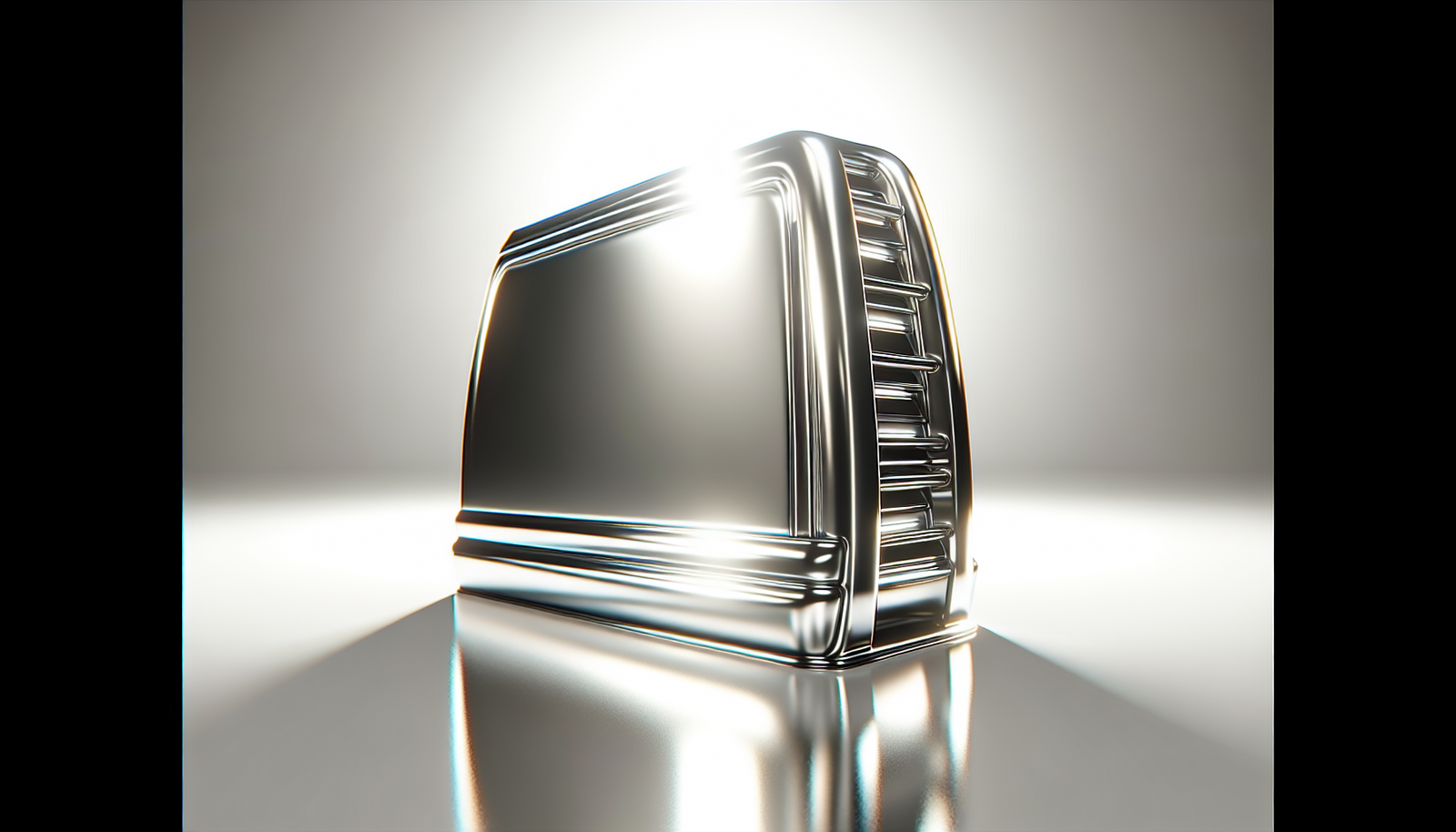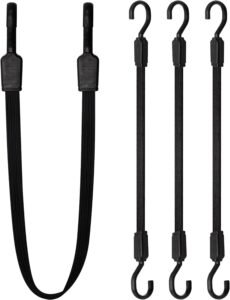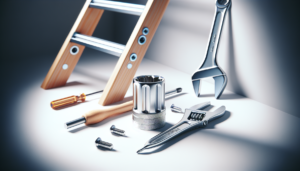
If you own an aluminum ladder rack, you’ve likely wondered how to keep it looking shiny and new. Well, maintaining the finish and appearance of an aluminum ladder rack is easier than you might think. By following a few simple tips and tricks, you can ensure that your ladder rack remains in top condition, withstands the test of time, and adds a touch of professionalism to your vehicle. From regular cleaning to protective measures, we’ll guide you through the best practices for preserving the finish and appearance of your aluminum ladder rack. Let’s dive in!
Cleaning and Washing
Preparation
To maintain the finish and appearance of your aluminum ladder rack, it is important to regularly clean and wash it. Before starting the cleaning process, make sure to prepare by gathering all the necessary tools and equipment. This will ensure that you have everything you need before getting started.
Cleaning Solution
Next, you will need to prepare a suitable cleaning solution. Avoid using abrasive cleaners, as they can damage the finish of your ladder rack. Instead, opt for a mild detergent mixed with warm water. This will effectively remove dirt and grime without harming the aluminum surface.
Tools and Equipment
When it comes to cleaning your ladder rack, certain tools and equipment will come in handy. Soft brushes or cloths are ideal for scrubbing away stubborn stains without scratching the surface. Additionally, a bucket, sponge, and hose will be useful for washing and rinsing the ladder rack.
Cleaning Process
To begin the cleaning process, wet the ladder rack with water from a hose. Then, dip a soft brush or cloth into the cleaning solution and gently scrub the aluminum surface. Pay special attention to any areas that have accumulated dirt or debris. Once you have cleaned the entire rack, rinse it thoroughly with water to remove any soap residue.
Drying
After rinsing, it is important to dry the ladder rack thoroughly. Leaving it wet can lead to water spots and streaks on the surface. Use a clean, dry cloth or allow the rack to air dry completely before moving on to the next step.
Polishing
To give your ladder rack a shiny and polished appearance, you can apply a suitable aluminum polish. This will not only enhance the overall look of the rack but also provide an additional layer of protection. Follow the instructions on the polish product carefully. Apply it evenly to the entire surface and buff it with a clean cloth to achieve a beautiful finish.
Removing Oxidation
Identifying Oxidation
Oxidation can occur on aluminum ladder racks over time, causing a dull and discolored appearance. To maintain the finish and appearance of your rack, it is important to identify and address oxidation promptly. Signs of oxidation include a chalky or white residue on the surface, as well as areas of discoloration.
Preparation
Before you can remove oxidation from your ladder rack, you will need to prepare the necessary tools and equipment. This may include mild detergent, warm water, soft brushes or cloths, a bucket, and a hose.
Cleaning Solution
To remove oxidation, you can use a slightly stronger cleaning solution than the one used for regular cleaning. Mix a mild detergent with warm water to create a solution that is effective in breaking down the oxidation.
Tools and Equipment
Similar to the cleaning process, soft brushes or cloths, a bucket, and a hose will be useful for removing oxidation. These tools will allow you to gently scrub the affected areas and rinse away the loosened oxidation.
Removing Oxidation Process
Start by wetting the ladder rack with water from a hose. Then, dip a soft brush or cloth into the cleaning solution and scrub the oxidized areas gently. Apply a bit of pressure to break down the oxidation but be careful not to damage the surface. After scrubbing, rinse the rack thoroughly to remove any residue.
Polishing
Once you have removed the oxidation, it is a good idea to polish the ladder rack to restore its shine and protect it from future oxidation. Follow the polishing process mentioned earlier to achieve a polished and protected finish.
Preventing Rust
Regular Inspections
To maintain the finish and appearance of your aluminum ladder rack, it is important to regularly inspect it for any signs of rust. Rust can severely damage the rack and affect its overall performance. By conducting regular inspections, you can identify and address any rust issues early on.
Protective Coating
One of the most effective ways to prevent rust on an aluminum ladder rack is by applying a protective coating. Aluminum-friendly paint or clear coat can provide a barrier between the metal surface and environmental elements, preventing rust from forming.
Clear Wax
Another option for preventing rust is to apply a clear wax to the ladder rack. The wax acts as a protective layer, sealing the surface and minimizing the risk of rust formation. Regularly applying clear wax can help maintain the appearance and prolong the lifespan of your ladder rack.
Cleaning Routine
Establishing a regular cleaning routine is crucial in preventing rust. By removing dirt, debris, and moisture from the surface of the ladder rack, you can minimize the conditions that favor rust. Make sure to clean the rack thoroughly and dry it completely after each use or exposure to moisture.
Avoid Exposure to Harsh Chemicals
Avoid using harsh chemicals or cleaning agents on your ladder rack, as they can accelerate rust formation. Stick to mild detergent and water for regular cleaning. If you need to use a stronger cleaning agent, make sure it is safe for use on aluminum and rinse the rack thoroughly afterward.
Storage
Proper storage is essential in preventing rust on an aluminum ladder rack. If possible, store the rack in a dry and covered area to protect it from rain, humidity, and other weather elements. Additionally, consider using a cover or tarp to provide an extra layer of protection.
Repairing Damage
Surface Scratches
Over time, your aluminum ladder rack may develop surface scratches. While these scratches do not affect the rack’s functionality, they can detract from its appearance. To repair surface scratches, you can use a suitable touch-up paint specifically designed for aluminum surfaces. Apply the paint according to the manufacturer’s instructions and let it dry completely before using the rack.
Patch Holes
If your ladder rack has developed small holes, you can patch them using an aluminum patch kit. These kits typically include a patch, adhesive, and instructions on how to apply them. Clean the area surrounding the hole, apply the adhesive, and affix the patch over the hole. Allow the adhesive to cure fully before subjecting the rack to any heavy loads.
Replacement of Components
In case of significant damage or wear to specific components of your ladder rack, it may be necessary to replace them. This could include replacement of crossbars, mounting brackets, or any other parts that are compromised. Contact the manufacturer or a professional for guidance on obtaining and installing the appropriate replacement parts.
Professional Assistance
For more extensive damage or repairs that you are unsure of, it is advisable to seek professional assistance. Professional technicians have the expertise and tools to handle complex repairs and ensure the safe and proper functioning of your ladder rack.
Repainting
If the finish of your aluminum ladder rack has become severely faded or damaged, you may consider repainting it. This can breathe new life into your rack and restore its appearance. Consult with professionals or trusted resources to ensure you follow the correct process and select the appropriate paint for aluminum surfaces.
Maintaining Fasteners
Inspecting Bolts and Nuts
Regularly inspecting the bolts and nuts that secure your ladder rack is crucial for maintaining its stability. Check for any looseness, signs of wear, or damage. Tighten any loose fasteners and replace any that are damaged or compromised.
Tightening Loose Fasteners
Even with regular inspections, fasteners can become loose over time due to vibrations and movement. Tighten any loose fasteners using appropriate tools, such as wrenches or sockets. Make sure to tighten them securely without over-tightening, as this can damage the rack.
Sealing Connections
To enhance the durability of your ladder rack and prevent rust, consider sealing the connections between different components. This can be done using waterproof sealants or adhesive products specifically designed for outdoor use. Apply the sealant to the connections and allow it to cure completely before subjecting the rack to heavy loads.
Lubrication
Adequate lubrication is essential for maintaining the smooth operation of moving parts on your ladder rack. Regularly apply a suitable lubricant, such as silicone spray or dry lubricant, to hinges, pivot points, and other areas that require movement. This will help prevent friction and ensure that the rack operates smoothly.
Replacing Damaged Fasteners
If you come across any damaged or worn-out fasteners during an inspection, it is crucial to replace them promptly. Using damaged fasteners can compromise the stability and safety of your ladder rack. Consult the manufacturer or a professional to ensure you obtain the correct replacement fasteners.
Storing the Ladder Rack
Covering and Protecting
When storing your ladder rack, it is important to cover and protect it from dust, dirt, and other elements that can affect its appearance and performance. Use a cover or tarp to shield the rack from external factors such as rain or snow.
Safe Storage Location
Choose a safe and secure storage location for your ladder rack. Ideally, this would be an area that is not prone to excessive moisture or extreme temperature changes. If possible, store the rack indoors to minimize its exposure to the elements.
Avoiding Excessive Weight
Avoid placing excessive weight on the stored ladder rack. Overloading it can lead to structural damage and decrease its lifespan. If additional items need to be stored on top of the rack, ensure that they are within the recommended load capacity and properly secured.
Proper Handling
When storing or moving the ladder rack, handle it with care to avoid any unnecessary damage. Lift the rack using proper lifting techniques, such as bending at the knees and using your leg muscles instead of your back. Avoid dragging or dropping the rack, as this can cause scratches or dents.
Regular Inspection
Periodically inspect the stored ladder rack for any signs of damage or wear. This will help you identify and address any issues before they worsen. Regular inspections can also ensure that the rack is in good condition and ready for use when needed.
Maintaining the Load Capacity
Regular Load Checks
To maintain the load capacity of your ladder rack, regularly check the weight of the items you are carrying. Ensure that the total weight does not exceed the recommended load capacity specified by the manufacturer. Overloading the rack can lead to structural damage and compromise its integrity.
Avoiding Overloading
It is essential to avoid overloading your ladder rack. Exceeding the recommended load capacity can lead to bending, warping, or even failure of the rack. Distribute the weight evenly across the rack and ensure that it is properly secured before starting any journey.
Proper Load Distribution
When loading items onto the ladder rack, distribute the weight evenly to maintain stability. Unevenly distributed weight can cause the rack to become unbalanced or tilt, increasing the risk of accidents. Make sure the heaviest items are placed at the center and distribute lighter items towards the sides.
Adjusting Tie-Downs
Regularly check and adjust the tie-downs used to secure items to the ladder rack. Over time, tie-downs can become loose or worn out. Tighten or replace them as necessary to ensure that your items are securely fastened.
Periodic Reinforcement
Consider reinforcing the load-bearing points on your ladder rack periodically. This can be done by adding extra support or braces to ensure the rack can handle heavy loads without compromising its integrity. Consult with the manufacturer or a professional to determine the best reinforcement method for your specific ladder rack.
Adhering to Manufacturer’s Guidelines
Reading the Instruction Manual
To ensure the proper maintenance of your aluminum ladder rack, it is crucial to read and understand the manufacturer’s guidelines. The instruction manual provides important information regarding the specific care and maintenance requirements of your rack. Familiarize yourself with the manual to ensure you are following the recommended practices.
Following Recommended Maintenance
In addition to reading the instruction manual, it is essential to follow the recommended maintenance practices outlined by the manufacturer. This may include specific cleaning methods, lubrication intervals, and other maintenance tasks. By following these guidelines, you can effectively preserve the finish and appearance of your ladder rack.
Avoiding Unauthorized Modifications
Avoid making any unauthorized modifications to your ladder rack. Modifying the rack in any way can compromise its structural integrity and affect its load capacity. Stick to the original design and consult the manufacturer or a professional if you have any specific requirements or concerns.
Contacting Support
If you have any questions, concerns, or need assistance with your ladder rack, do not hesitate to contact the manufacturer’s support. They can provide valuable guidance, answer any queries, and offer solutions to any issues you may encounter.
Warranty Coverage
Check the warranty coverage for your ladder rack. Understanding the terms and conditions of the warranty can help you navigate any potential repairs or replacements that may be covered. Be sure to comply with any warranty requirements, including regular maintenance and authorized repairs, to ensure the validity of the warranty.
Safety Considerations
Inspecting for Structural Damage
Before each use, inspect your ladder rack for any signs of structural damage. Look for cracks, bends, or any other indications of compromise. Using a damaged rack can be dangerous, so it is important to address any issues promptly.
Securing the Rack Properly
Ensuring that your ladder rack is properly secured is crucial for safety. Before driving, double-check that the rack is securely attached to your vehicle and any items on the rack are secured with tie-downs. Loose racks or items can shift during transit and pose a hazard to you and other drivers.
Using Proper Lifting Techniques
When loading or unloading items onto the ladder rack, use proper lifting techniques to avoid strain or injury. Lift with your legs, not your back, and avoid overexerting yourself. If an item is too heavy or awkward to lift safely, ask for assistance.
Preventing Slips and Falls
Take precautions to prevent slips and falls when using your ladder rack. Ensure that the area around the rack is clear of obstacles and debris. Use appropriate footwear with good traction to minimize the risk of slipping. Always exercise caution when climbing onto or down from the rack.
Avoiding Overreach
Avoid overreaching or stretching too far when accessing items on your ladder rack. Overreaching can compromise your balance and stability and increase the risk of accidents. Whenever possible, use a suitable ladder or step stool to access items on the rack safely.
Regular Cleaning Tips
Using Non-Abrasive Cleaners
When cleaning your aluminum ladder rack, it is important to use non-abrasive cleaners. Abrasive cleaners can scratch the surface and damage the finish. Stick to mild detergents or cleaners specifically designed for aluminum surfaces to ensure a safe and effective cleaning process.
Soft Brush or Cloth
To avoid scratching the surface of your ladder rack, use a soft brush or cloth for scrubbing. These tools will effectively remove dirt and debris without causing any damage. Avoid using rough or abrasive materials that can leave scratches or marks.
Avoiding Pressure Washers
While pressure washers can be efficient for cleaning, they can also be too powerful and potentially damage the finish of your ladder rack. Instead, opt for the gentler approach of handwashing with a soft brush or cloth. This will ensure the cleaning process is effective without compromising the appearance of the rack.
Removing Stubborn Stains
If you encounter stubborn stains or marks on your ladder rack, you may need to use a slightly stronger cleaning method. Mix a small amount of baking soda with water to create a paste. Gently rub the paste onto the stained area using a soft brush or cloth. Rinse thoroughly with water afterward.
Cleaning Routine
Establishing a regular cleaning routine for your ladder rack is essential in maintaining its finish and appearance. Depending on the frequency of use and the environmental conditions it is exposed to, aim to clean your rack at least once a month or as needed. Following a consistent cleaning routine will help preserve the rack’s aesthetics and prolong its lifespan.
By following these comprehensive maintenance tips, you can ensure that your aluminum ladder rack stays in excellent condition for years to come. Regular cleaning, proper storage, and adherence to safety guidelines will help maintain the finish and appearance of your rack while ensuring its safe and reliable performance. Remember to consult the manufacturer’s guidelines and seek professional assistance when needed. With proper care and maintenance, your ladder rack will continue to serve you well and provide the support you need for your work and recreational activities.





